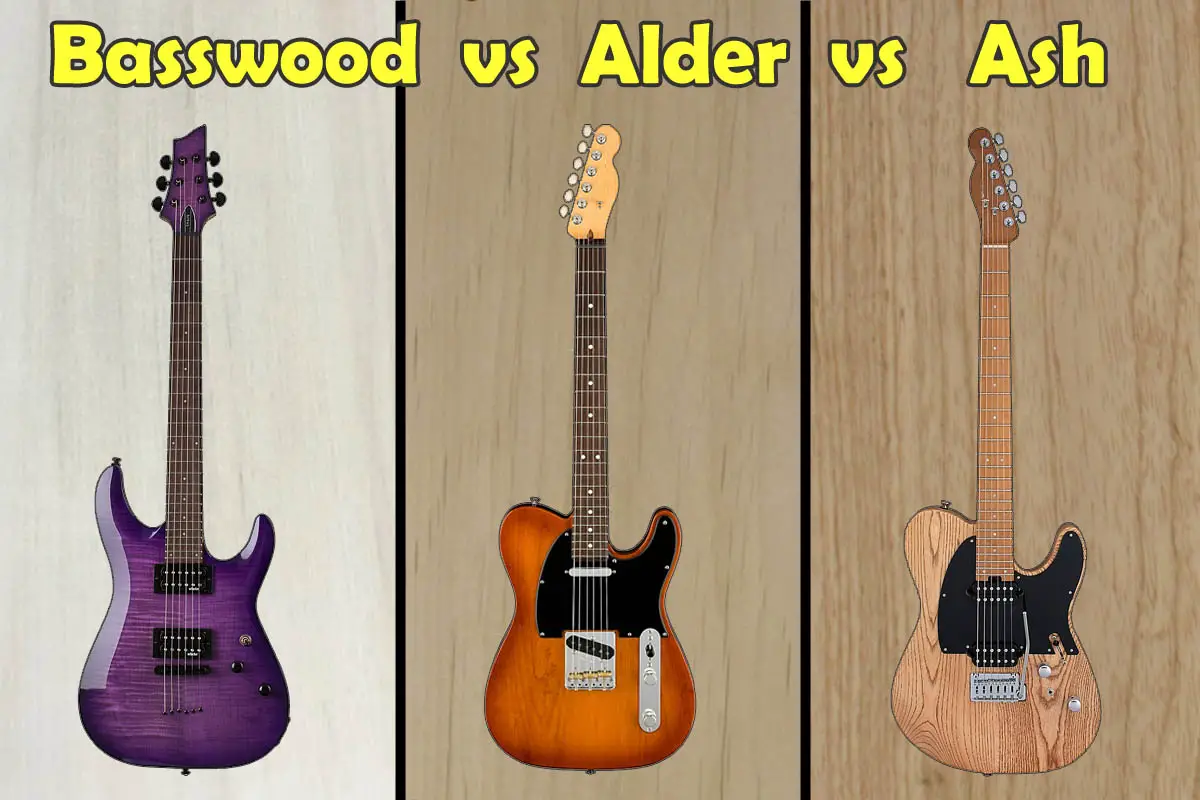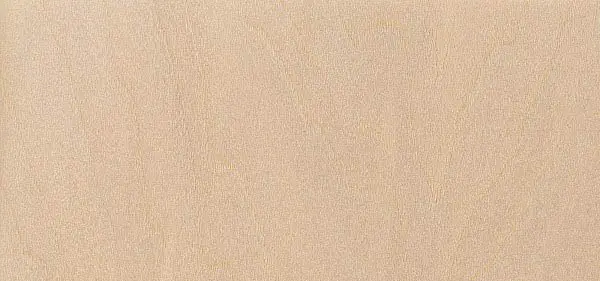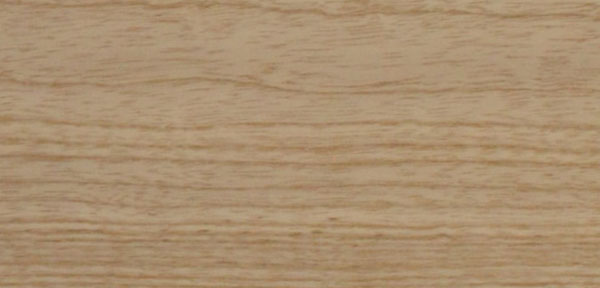Basswood vs Alder vs Ash Guitars (What’s the Difference?)
With modern day electric guitars you will find basswood used more than ever before, while Alder remains a tried-and-true classic loved by many guitarists.
Black Ash and swamp ash have also been a favorite for guitar manufacturers for decades, however due to climate change and other factors, swamp ash has become in short supply.
Basswood, Alder, and Ash have different properties that make them good for making guitars that feel different to hold and play.
- Basswood gives a strong warm midrange, compared to Red alder’s rich strong lows and more pronounced upper-midrange tones.
- Swamp ash reveals rich bass though to light high tones, with harder ash giving a resonant brighter top-end.
- Alder gives a warm well-balanced tone somewhere in-between basswood and ash.

Many guitarists say guitars made with these woods sound very different to each other, but how different are they really?
What Type of Wood is Basswood?
Basswood is known by a few different names: Basswood, American Basswood, Lime, and Linden, and its scientific name is Tilia Americana. Its name is pronounced as ‘bhass – wood’ (Bass – like the fish), and it is also known as the ‘bee tree’.
Although one of its names is Lime wood, this is due to the mineral lime green streaking in the grain that is frequently visible, not because of any relation to citrus Lime.

Basswood is technically classed as a hardwood due to its seeds having a hard shell surrounding them and is a soft-grained wood that is easy to work with and compress.
Basswood Weight & Strength
The hardness rating for basswood is 420 Janka, which places it on the low end of hardwoods.
Generally, Basswood is light compared to other hardwoods, although like other woods it can be heavier if growth is slower in a different climate.
This is one of the strengths of basswood as it has a similar weight to alder, having a good weight that is light enough to easily hold but heavy enough to stop body-slap.
Basswood is quite a soft hardwood, and guitar bodies are easily dented if they take a knock. For this reason, many basswood guitars have a thick lacquer applied to them for protection.
Some basswood guitar owners have said that hardware has become loose over a few years due to the softness of the wood.
Basswood Appearance
The appearance of Basswood is a plain grain pattern, displaying a uniform pale white to brown color.
Some guitarists dislike the plain look of basswood, and especially the cuts that have mild lime streaks through them.
Woodworkers have noticed that it darkens over time, as many woods do, so the relatively bland appearance may improve a little with age.
What Do Basswood Guitars Sound Like?
Basswood boosts mid-range, with a warm tone. Being a light and soft wood makes it resonate at lower frequencies.
Although this is a common property of basswood, you can find that two different cuts can sound quite different when tapped, having different tonal qualities depending on where the tree grew and what part of the tree the lumber came from.
Higher end guitars use better cuts of basswood than the cheap versions and are normally lighter, giving extra clarity to the tone.
American basswood is generally lighter than its Asian counterpart and resonates with higher mid-range tones.
“Baswood …produces a fairly even and full to mid-range response throughout the entire band width. Many guitar enthusiasts agree that it’s well matched with humbucking pickups because basswood produces a lot of the same frequencies that pickups easily recreate”.
Ernie Ball Music Man
Lighter cuts of basswood are usually preferred to the heavier ones, as it produces a more pleasing tone that accentuates the upper middle ranges. Heavier basswood guitars sound a bit more ‘muddy’ having a lower frequency tonal response.
Basswood is popular in guitars for heavier musical styles since it produces a good punchy midrange tone that helps cut through the audio mix, particularly when soloing.
What Type of Wood is Alder?
Alder grows mostly in the Pacific Northwest, where it is abundant hardwood

Being a relatively soft hardwood, it sits closer to basswood in hardness than to ash. It is a good wood for guitars since it flexes easily for good sound transference, is easily worked with by machinery, and is very stable for fixing hardware to.
Alder grows easily and is resistant to disease, meaning it is readily available at prices that make it good for guitar making.
Alder Weight
Out of all the widely used woods for guitar making, Alder at 590 Janka hardness is one of the closest to basswood.
Alder is popular with guitarists as a wood that is nicely resonant without being too heavy to gig with. It’s quite similar in weight to basswood, but is stronger with a more vibrant midrange sound.
Alder Appearance
Alder is an evenly textured wood, with a subdued grain pattern. It is easy to sand, paint, or stain to a good finish, drying to an even honey tone.
The grain is reasonably fine and is ideal for light or natural finishes, and can also be finished to look like more expensive tight-grained wood.
Alder is a little bland for an instrument finish, so normally has a solid finish applied, giving a nice flat surface with almost no trace of the grain underneath.
What Do Alder Guitars Sound Like?
Like other woods, there are different strains of alder, however with an abundance of red alder and its great tonal properties it soon became a favorite for many Fender guitars.
Fender regularly features alder in their Stratocasters, Jaguars, Jazzmasters, and Jazz Bass.
Red alder has rich and strong lows to mids, with more pronounced upper midrange tones than basswood, giving a warm well-balanced tone somewhere in-between basswood and ash.
What Type of Wood is Ash?
Types of ash commonly used for making guitars are black ash, white ash, swamp ash, and European ash.

European ash and white ash have an appearance so similar that their origin is impossible to know by simply looking at the wood.
Swamp ash is not a type of ash, but rather defines where the tree grew, being in wet swampy areas.
Ash Weight & Strength
There are many different varieties of ash that vary in hardness from black ash and swamp ash (softer varieties) through to white ash which is 1320 on the Janka hardness scale.
Black ash (990 Janka) is harder than basswood, and is similar in weight to maple. It is a good choice for guitar bodies due to the bright tone and good sustain it produces and is more durable than basswood.
Swamp ash is softer than hard ash, but still much harder than basswood, and is a lightweight wood that gives guitars a good weight distribution.
With black ash having good acoustic properties, high availability, a pleasing appearance, and being readily available – it is commonly found in guitar construction.
Ash was used for many early Fender electric guitars, but made them very heavy instruments for standing with.
Ash of all types is a strong hardwood that is good for guitar bodies with resistance to dents, and good for hardware mounting strength.
Ash Appearance
Ash generally has a straight grain with a light brown color. Black ash has a stronger grain appearance than white ash, and has closer growth rings.
With ash having a nice straight grain, and good visible characteristics it makes a great wood for guitar bodies.
Although ash comes in straight grained cuts, there are also plenty that have arch and ellipse patterns. When finished with a clear-coat, ash guitars can have a really pleasing appearance with enough grain to make them stand out.
With its variation in grain, ash guitars are more commonly finished in light shades and clear coats than the plainer-grained alder.
What Do Ash Guitars Sound Like?
Swamp ash is a softer variety of ash which gives rich bass tones though to light high tones, and is often preferred to harder ash for its smooth timbre.
Harder ash gives a brighter top-end slightly sacrificing bass response, and is very resonant with great sustain.
Ash makes a great body for humbuckers in the bridge position, and single coils at the neck.
Is Basswood Good for Acoustic Guitars?
Basswood isn’t generally used for making acoustic guitar bodies, apart from the furling that joins the top, back, and sides together.
An ideal wood for making resonant guitar tops needs to have good stiffness, and basswood is too soft and flexible. Basswood is only found in cheap acoustic guitars, the sort you’ll probably start out on as a beginner for around $100.
Those cheaper guitars usually have soundboards made from laminated spruce with basswood back and sides. Even then, you will find these models can have a lifeless flat sound with little resonance.
Is Alder Good for Acoustic Guitars?
Similar to basswood, alder is not considered a suitable wood for acoustic guitar making.
Is Ash Good for Acoustic Guitars?
Although some sites claim that ash isn’t used for acoustic guitars, it has in fact been used for the back and sides of quite a few acoustic guitars.
Being a lightweight hardwood it’s not the most ideal acoustic body wood, but gives a better resonance than basswood.
Even though it’s use is not widespread, some well known manufacturers like Larivee, Guild, and Martin have made models with ash. While not known as remarkable guitars, guitarists report that they have a well-balanced tone.




